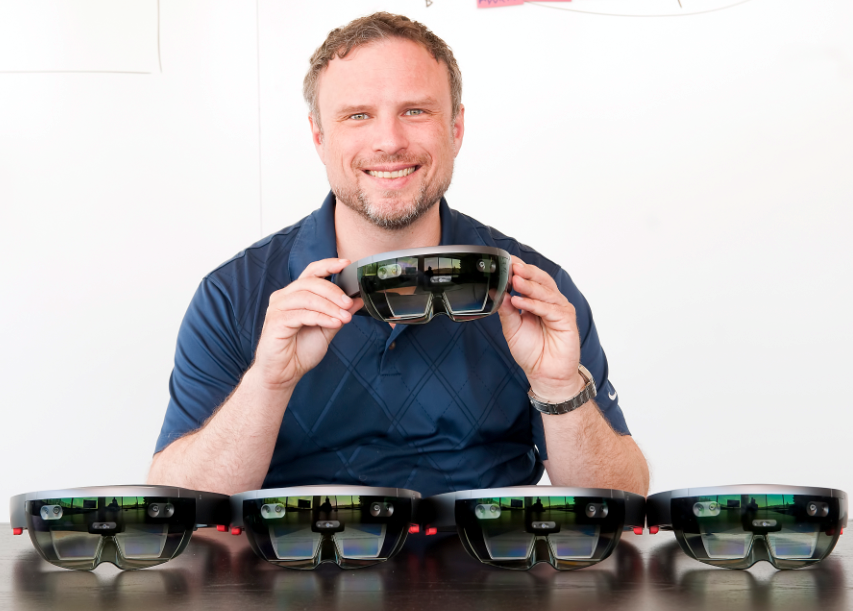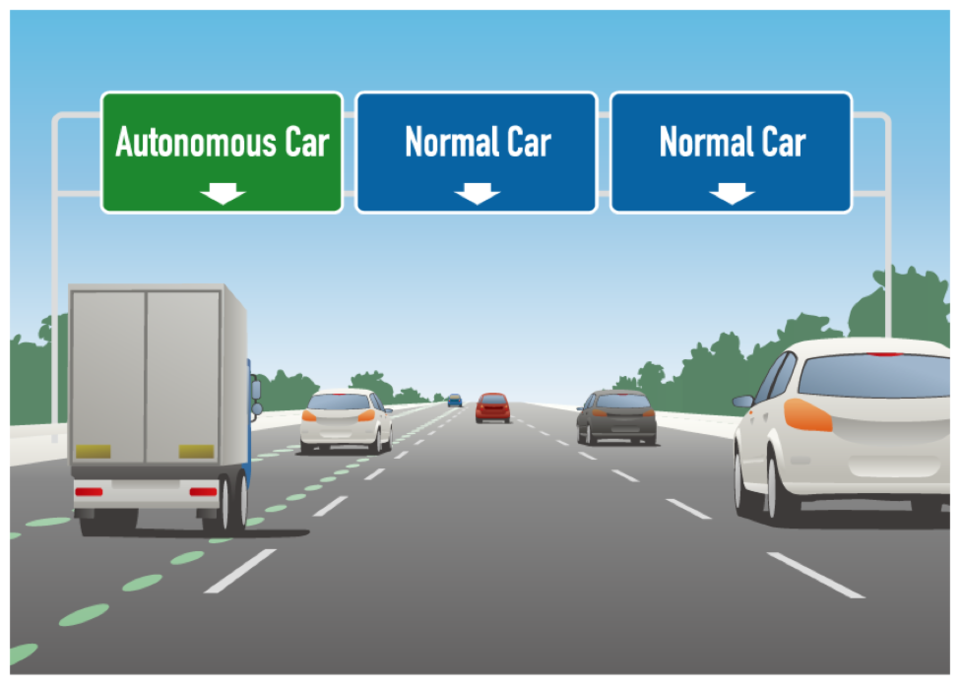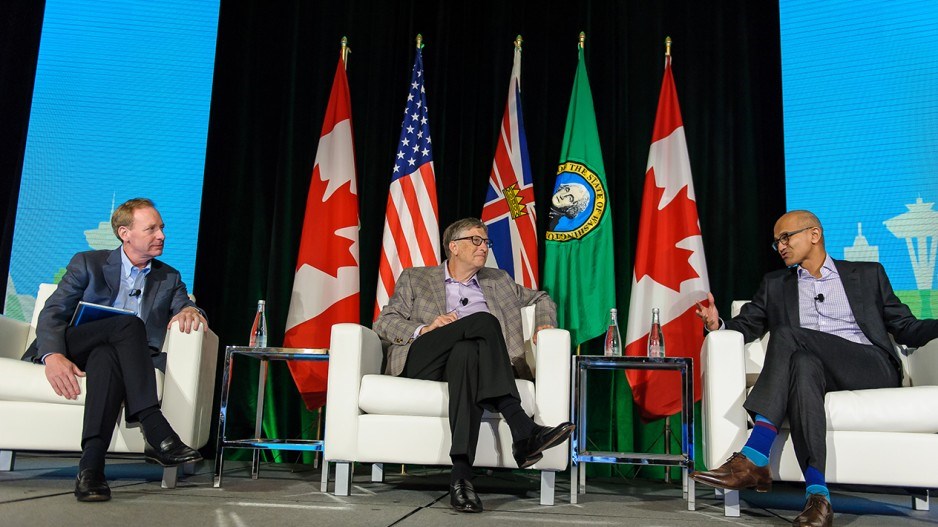Holograms shouldn’t take up too much storage space in a physical location. They’re made of light after all and can be turned off with the push of a button.
But after Microsoft (Nasdaq: MSFT) representatives toured Finger Foods Studio’s 26,000-square-foot hologram facility, they had a warning for the Port Coquitlam tech company’s CEO: “‘You guys are going to run out of space,’” Ryan Peterson recalled one visitor telling him.
The digital agency is one of the few in the world specializing in Microsoft’s HoloLens augmented reality headset.
Finger Foods has already used the hardware and its facility to build a life-sized hologram of a semi-truck with a trailer for Microsoft’s Redmond, Washington, neighbour, Paccar. Companies like Paccar can dramatically cut costs on designing expensive machinery if they can view them at scale and make any necessary changes.
“We’re going to be moving from two holographic projects to 10 in the next 12 months,” Peterson said, “and that’s going to result in 100 new jobs in our facility.”
Hours before Peterson played tour guide, Microsoft CEO Satya Nadella gave Finger Food Studios a shout-out in front of hundreds of attendees at the September 20 Emerging Cascadia Innovation Corridor conference in downtown Vancouver.
The summit brought together tech experts and policy-makers to discuss the prospects of further integrating Vancouver’s and Seattle’s respective innovation sectors.
The governments of B.C. and Washington kicked off the conference by agreeing to collaborate on a “tech corridor” intended to create more economic opportunities between the regions’ tech sectors.
While the two cities might seem like a perfect fit based on culture and geography, “data shows that their level of connectedness is more akin to cities that are 2,000 miles apart,” according to a white paper prepared for the conference by the Boston Consulting Group (BCG).
The BCG report found that the University of Washington collaborates more closely with 49 other universities than it does with the neighbouring University of British Columbia.
But Peterson said companies like Finger Food Studios are proof the Cascadia economic corridor is already bearing fruit, despite some challenges.
Without close connections between his employees who previously worked at Burnaby’s Electronic Arts and workers now employed at Microsoft, he doubts his company would have been able to begin working on the HoloLens project.
“We’re living it,” he said.

Photo: Finger Food Studios CEO Ryan Peterson showcases the Microsoft HoloLens
The BCG report pitched solutions such as better immigration policies to make travel easier between the cities as well as transportation initiatives to shrink the “not insubstantial” distance between the cities.
“Four hours in a car just doesn’t work,” John Wenstrup, a senior partner at BCG, told the conference.
His report proposed efforts such as a high-speed rail line to link the two cities.
Dow Constantine, the executive of King County, proposed the same idea during a panel also featuring former B.C. transportation minister Kevin Falcon.
He said high-speed rail would help attract global companies to the region as opposed to forcing Seattle and Vancouver to compete against one another.
Constantine’s pitch envisioned a two-track train running between 320 km/h and 400 km/h that would run 24 hours a day. He said it would help eliminate border lineups and passengers should expect to use the latest technology to make processing at the border swifter.
He suggested funding it through a public-private partnership, although he did not provide a price estimate for such an endeavour.
Falcon, meanwhile, said he understands the risks associated with these types of mega-projects that might have “absurdly optimistic” business cases.
He said many of these risks could be managed through public-private partnerships and sufficient political will.
“We cannot lose sight of the mutual benefits that arise from connecting our two great cities.”
Falcon added that Vancouver still “punches well below its weight” in terms of attracting head offices.
Tom Alberg, managing director at Seattle-based Madrona Venture Group, co-authored a report earlier this month noting that high-speed rail between Vancouver and Seattle would likely cost between US$20 billion and US$30 billion.
“The dream of high-speed rail is great,” Alberg told Business In Vancouver. “It’s unlikely given the cost and the timeframe.”
Instead, his report proposes the development of dedicated lanes for autonomous cars between Vancouver and Seattle.
Driverless cars could initially be deployed in carpool lanes along the I-5. Meanwhile, autonomous vehicles could run along Highway 99 between the Peace Arch border crossing and the Bridgeport SkyTrain station in Richmond.
The report says within 10 to 15 years, driverless cars could reduce traffic accidents, clear congestion and free drivers up to do more productive work while travelling between Vancouver and Seattle.

Ray Walia, CEO of Vancouver’s Launch Academy incubator, started his own Cascadia Summit in 2012 to attract Silicon Valley venture capitalists to the region.
“People [in Seattle] don’t care as much about Vancouver, especially from a tech perspective — San Francisco is the Mecca,” he said. “As a [Vancouver] startup, I’m not going to focus on going to Seattle when it’s the same amount of time and money to get to San Francisco. The difference is either I’m driving or I’m flying.”
But Walia said if the region worked together, it would become more enticing to foreign investors who’d otherwise choose just one city to focus on.
Former Washington state governor Chris Gregoire, who now serves as CEO of Challenge Seattle, told the conference that Seattle and Vancouver both qualify as global “beta” cities as opposed to “alpha” cities like Toronto or San Francisco.
“I don’t mean to be a Debbie Downer here, but I don’t know about the possibility of Vancouver becoming an alpha or Seattle becoming an alpha,” she said.
“But I do believe working together our chances are greatly enhanced [and] that as a corridor we can become a region that is recognized similarly.”
@reporton



